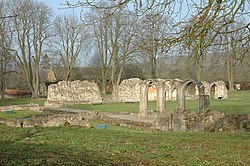
Hailes Castle was a castle in the village of Hailes in Gloucestershire, England.
Contents
The castle was built around the 11th or early 12th century near the church in the village. [1] The castle was moated, although this has since been filled in. [1] The castle was strengthened by Ralph of Worcester at the start of the difficult years of the Anarchy, with Hailes Castle playing a role in the conflict between 1139 and 1145. [2] The castle was probably demolished in the 1240s to make way for the construction of Hailes Abbey. [1]